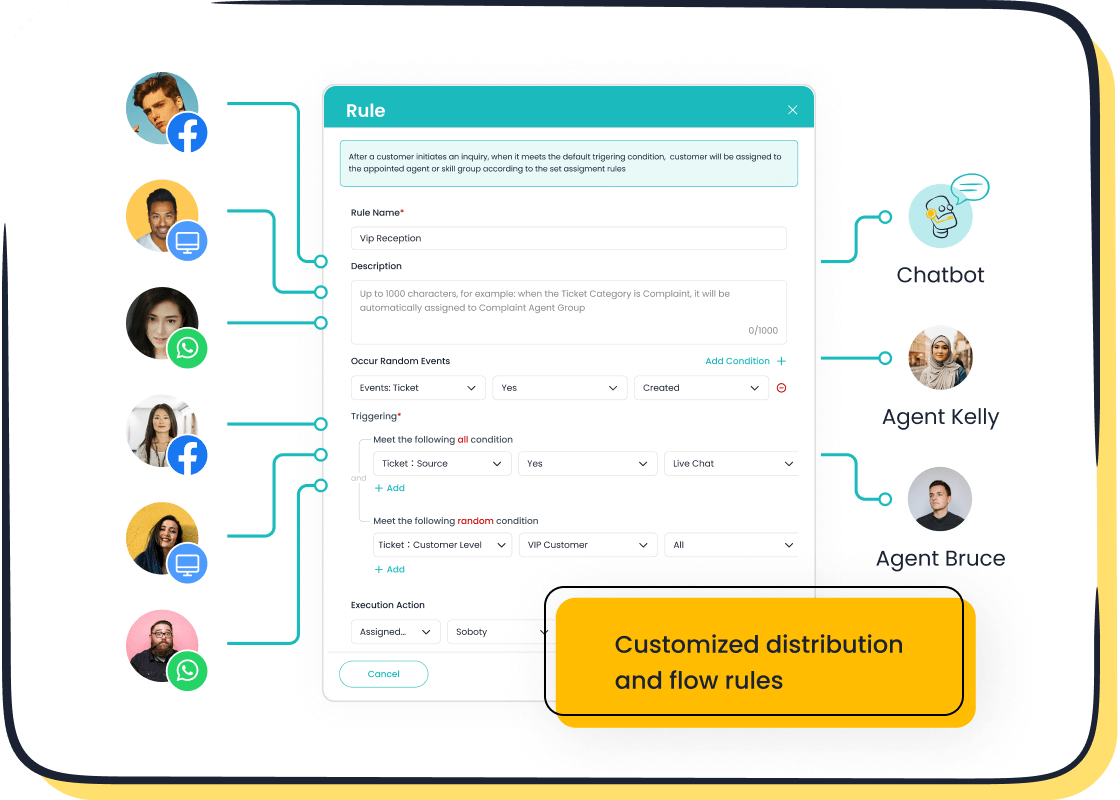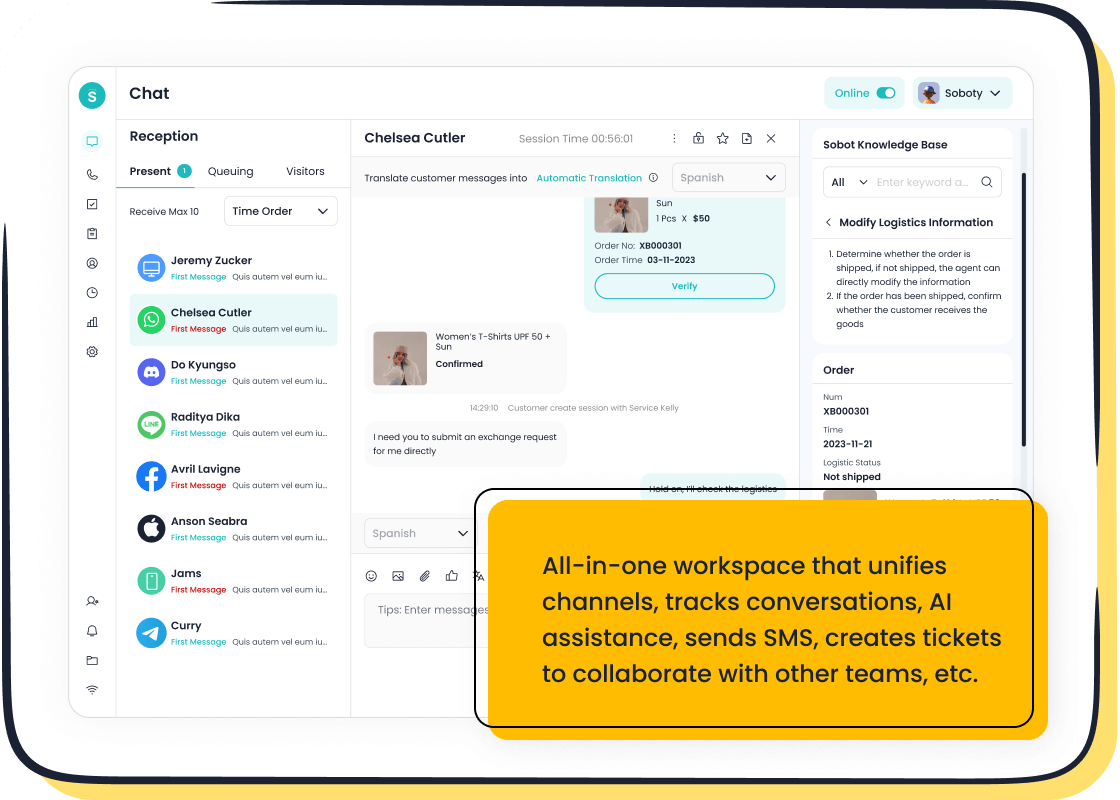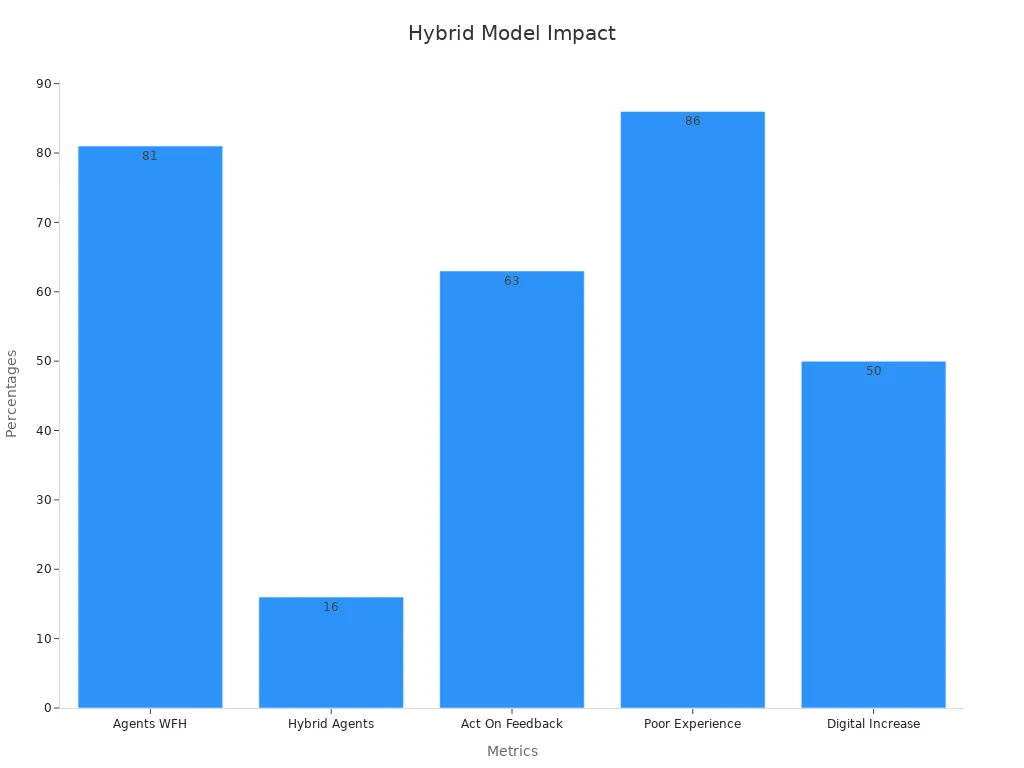How Live Agents and AI Chatbots Complement Each Other in Support

In customer support, live agents and AI chatbots each excel in unique ways. While AI chatbots handle repetitive tasks efficiently and reduce wait times, live agents bring empathy and problem-solving skills to complex situations. Together, they enhance customer satisfaction and streamline processes. For example, chatbots can automate responses, saving up to 30% in support costs, while live agents focus on improving customer experience. Businesses using hybrid models, like Sobot's live chat solutions, often achieve better workflow and improved customer satisfaction. This synergy ensures faster resolutions and a more personalized experience for customers.
Defining Live Agents and AI Chatbots in Customer Support
What Are Live Agents in Customer Service?
Live agents are human representatives who provide direct assistance to customers. They excel in understanding complex issues, offering empathy, and delivering personalized solutions. When you contact customer support, live agents often handle intricate problems that require critical thinking or emotional intelligence. For example, if a customer faces a billing dispute, a live agent can analyze the situation, explain the charges, and resolve the issue effectively.
Live agents also adapt to unexpected scenarios. Their ability to think creatively and communicate naturally makes them indispensable in customer service. According to industry reports, 75% of consumers prefer interacting with live agents for their support needs. This preference highlights the importance of human interaction in building trust and ensuring customer satisfaction.
What Are AI Chatbots and Their Role in Customer Support?
AI chatbots are automated tools designed to assist customers by answering questions and resolving issues. These chatbots use artificial intelligence to simulate human-like conversations. They are available 24/7, making them ideal for handling repetitive tasks like order tracking or FAQs. For instance, Sobot's AI chatbot can resolve customer inquiries with a 71% success rate, ensuring quick and accurate responses.
AI chatbots also gather data from customer interactions, providing valuable insights into preferences and behaviors. Businesses use this information to refine their strategies and improve customer experiences. In 2022, 37% of the U.S. population interacted with a bank's chatbot, showcasing the growing reliance on this technology. By automating routine tasks, AI chatbots allow live agents to focus on more complex issues, creating a balanced and efficient support system.
Key Differences Between Live Agents and AI Chatbots
Understanding the key differences between live agents and AI chatbots helps you determine their roles in customer support. While live agents excel in empathy and problem-solving, AI chatbots offer efficiency and scalability. The table below highlights these differences:
| Criteria | Chatbot | Live Chat |
|---|---|---|
| Human Interaction | Limited; automated responses | Direct interaction with human agents |
| Availability | 24/7 | Limited by staffing schedules |
| Scalability | Handles multiple conversations simultaneously | Dependent on agent availability |
| Cost | Lower operational costs | Higher due to staffing |
| Complexity of Queries Handled | Simple to moderate | Complex and nuanced |
| Personalization | Basic user data | High-level personalization |
For example, Sobot's AI chatbots handle repetitive queries efficiently, while its live chat solution ensures personalized customer service. This combination creates a seamless experience, addressing both simple and complex needs.
Strengths and Limitations of Live Agents
Empathy and Problem-Solving Skills of Live Agents
Live agents bring a human touch to customer service that technology cannot replicate. When you interact with a live agent, you benefit from their ability to empathize with your situation and provide tailored solutions. For example, if you’re frustrated about a delayed order, a live agent can acknowledge your concerns, apologize sincerely, and offer a resolution that feels personal. This emotional connection builds trust and enhances your overall experience.
Live agents also excel at solving complex problems. Unlike chatbots, which follow predefined scripts, live agents can think critically and adapt to unexpected scenarios. They analyze issues in real time, ask clarifying questions, and offer creative solutions. For instance, if a customer faces a technical issue with a product, a live agent can guide them step-by-step through troubleshooting, ensuring the problem is resolved effectively.
Metrics further highlight the strengths of live agents in customer service. The table below illustrates how their empathy and problem-solving skills translate into measurable outcomes:
| Metric | Description |
|---|---|
| Average Handling Time (AHT) | Balances efficiency with empathy by resolving issues promptly while addressing customer emotions. |
| Customer Satisfaction (CSAT) | Reflects the emotional impact of interactions, showcasing the agent's ability to connect with customers. |
| First Call Resolution (FCR) | Measures the success of resolving issues in a single interaction, demonstrating problem-solving efficiency. |
| Agent Well-Being | Indicates job satisfaction and emotional health, which directly influence customer interactions. |
Sobot’s live chat solution enhances these strengths by equipping live agents with AI-assisted tools. These tools streamline workflows, allowing agents to focus on delivering empathetic and effective support. For example, Sobot’s unified workspace integrates customer data, enabling agents to personalize interactions and resolve issues faster.
Challenges Faced by Live Agents in Customer Support
Despite their strengths, live agents face several challenges in customer service. High workloads and repetitive tasks often lead to employee burnout, which reduces service quality and increases turnover. When agents leave, businesses must invest time and money in recruitment and training, further straining resources.
Language barriers also pose difficulties. If your business serves a diverse customer base, communication gaps can lead to misunderstandings and dissatisfaction. Additionally, evolving customer expectations demand swift resolutions, but skill gaps among agents may prevent them from meeting these demands consistently.
Here are some common challenges live agents encounter:
- Employee Burnout: High turnover impacts service quality and raises operational costs.
- Recruitment and Training Difficulties: Finding and training new agents is time-intensive and expensive.
- Language Barriers: Miscommunication with diverse customers can harm satisfaction.
- Insufficient Customer Engagement: Generic responses may fail to build loyalty.
- Evolving Customer Expectations: Customers expect faster resolutions, which can be difficult to achieve without proper training.
Sobot addresses these challenges by integrating AI-powered tools into its live chat platform. Features like intelligent assignment and AI copilots reduce agent workloads by automating repetitive tasks. Auto-translation bridges language gaps, enabling agents to communicate effectively with customers worldwide. These innovations empower live agents to overcome obstacles and deliver exceptional customer service.
Strengths and Limitations of AI Chatbots
Efficiency and Availability of AI Chatbots
AI chatbots revolutionize customer support by offering unmatched efficiency and 24/7 availability. Unlike live agents, chatbots never take breaks, ensuring your customers receive assistance at any time. This constant availability enhances customer satisfaction and fosters loyalty. For instance, chatbots can instantly respond to inquiries, reducing wait times and providing real-time solutions. This capability is essential in today’s fast-paced environment, where quick service is highly valued.
Chatbots also excel in handling repetitive tasks, such as answering FAQs or tracking orders. By automating these processes, they save time and allow live agents to focus on handling complex issues. Businesses like HelloSugar have reported automating 66% of customer queries, saving $14,000 monthly. Similarly, Lush saves 360 agent hours each month by using AI chatbots, demonstrating their efficiency in streamlining operations.
Evaluations of chatbot performance often measure aspects like response speed, natural language understanding, and scalability. The table below highlights key evaluation criteria:
| Evaluation Aspect | Description |
|---|---|
| Natural Language Understanding | Assess if the bot understands context and nuances. |
| Response Speed | Ensure quick, precise replies during high traffic. |
| Adaptability and Scalability | Simulate peak traffic to test load capacity and manage inquiries efficiently. |
| Cost Analysis and ROI | Compare implementation expenses with potential operational cost savings. |
By integrating AI chatbots, you can reduce costs, scale support, and improve agent efficiency. Sobot’s AI-powered chatbots, for example, provide instant responses and automate repetitive tasks, ensuring seamless customer interactions.
Limitations of AI Chatbots in Handling Complex Customer Needs
Despite their strengths, AI chatbots face challenges in handling complex issues. They rely on predefined algorithms, which limit their ability to adapt to nuanced or sensitive situations. For example, chatbots may struggle with technical problems or billing disputes that require human expertise. In such cases, live agents remain indispensable.
The table below outlines some limitations of AI chatbots:
| Limitation Type | Description |
|---|---|
| Limited ability to handle complex scenarios | AI chatbots struggle with intricate cases requiring human expertise and diagnostic assessments. |
| Technological constraints and adaptability | Chatbots need technical enhancements to manage diverse and sensitive customer environments. |
While chatbots can escalate unresolved queries to live agents, this process may delay resolutions. Additionally, chatbots lack emotional intelligence, which is crucial for building trust during sensitive interactions. For instance, a chatbot cannot empathize with a frustrated customer or offer personalized solutions.
To overcome these limitations, businesses often adopt a hybrid approach. Sobot’s AI chatbots seamlessly integrate with live chat solutions, ensuring that complex queries are escalated to human agents efficiently. This collaboration enhances accuracy in solving issues and ensures a balanced customer support system.
Scenarios Where Live Agents and AI Chatbots Excel

When to Use Live Agents for Customer Service
Live agents shine in situations requiring empathy, critical thinking, and personalized solutions. If a customer faces a billing dispute or a technical issue, a live agent can analyze the problem, ask clarifying questions, and provide tailored resolutions. Their ability to connect emotionally builds trust and enhances the customer experience. For example, 42% of customers prefer real-time online chat for immediate assistance, and live chat resolves most issues in just 42 seconds. High spenders, especially those spending $250-$500 monthly, show 63% more loyalty to companies offering live chat services.
Live agents also excel in handling complex queries that demand contextual understanding. Whether it’s guiding a customer through a sensitive issue or offering tailored recommendations, their human touch ensures satisfaction. Sobot’s live chat platform equips agents with tools like intelligent assignment and unified workspaces, enabling them to deliver efficient and personalized customer service.
When AI Chatbots Are Ideal for Customer Support
AI chatbots are perfect for tasks requiring efficiency and scalability. They handle repetitive customer queries like FAQs, order tracking, and account updates with ease. Available 24/7, chatbots ensure customers receive immediate assistance, even during peak hours. Metrics like problem resolution rates and customer satisfaction surveys validate their effectiveness. For instance, a high resolution rate indicates that chatbots successfully resolve inquiries without escalating them to live agents.
Chatbots also reduce abandonment rates by providing quick responses and retaining customers who might otherwise leave due to delays. Retention rates further highlight their ability to deliver quality experiences that encourage repeat interactions. Sobot’s AI chatbot integrates seamlessly with live chat systems, ensuring smooth transitions for complex queries that require human intervention.
Industry-Specific Applications of Live Agents and AI Chatbots
Different industries leverage live agents and AI chatbots based on their unique needs. In health insurance, AI chatbots assist customers in selecting Medicare plans by collecting essential data before routing them to live agents. This hybrid approach improves efficiency and satisfaction. Retail and e-commerce businesses use AI chatbots for repetitive tasks like order tracking, while live agents handle complex customer queries related to product recommendations or disputes.
The table below illustrates their applications across industries:
| Feature | AI Chatbots | Live Agents |
|---|---|---|
| Availability | 24/7 instant replies | Limited to working hours |
| Task Handling | Handles repetitive tasks | Deals with complex issues |
| Cost | Cost-effective for high volume | Higher operational costs |
| Customer Engagement | Proactive messaging | Personalized interaction |
| Integration | Omnichannel support | Requires manual handling |
Sobot’s solutions, such as its AI-powered chatbots and live chat platform, enable businesses to optimize customer service across industries. For example, OPPO achieved an 83% chatbot resolution rate and a 94% positive feedback rate by combining AI chatbots with live agents, showcasing the power of human-machine collaboration.
The Hybrid Approach: Combining Live Agents and AI Chatbots

How Sobot Live Chat Enhances Hybrid Customer Support

Combining live agents and AI chatbots creates a powerful hybrid system that balances efficiency with human empathy. Sobot Live Chat exemplifies this approach by seamlessly integrating AI-powered tools with human expertise. This platform allows AI chatbots to handle repetitive tasks, such as answering FAQs or tracking orders, while live agents focus on complex issues requiring critical thinking and emotional intelligence.
Sobot Live Chat’s unified workspace ensures smooth collaboration between AI chatbots and live agents. For instance, when a chatbot encounters a complex query, it escalates the issue to a live agent with all relevant customer data intact. This seamless handoff minimizes delays and enhances the customer experience. Additionally, features like intelligent assignment and AI copilots reduce agent workloads, enabling them to deliver personalized support more effectively.
By leveraging Sobot Live Chat, businesses can provide immediate assistance through AI chatbots while ensuring high-quality service for more nuanced customer needs. This hybrid model not only improves efficiency but also fosters customer satisfaction and loyalty.
Benefits of Integrating Live Agents and AI Chatbots
Integrating live agents with AI chatbots offers numerous benefits that enhance both operational efficiency and customer satisfaction. This hybrid approach allows you to combine the strengths of both systems, creating a balanced and effective support strategy.
Here are some key advantages:
- Cost Savings: Chatbots can reduce operational costs by up to 30%, making them a cost-effective solution for handling high volumes of inquiries.
- Efficiency: AI chatbots manage up to 59% of all chats, freeing live agents to focus on complex and high-value interactions.
- Customer Retention: Companies using chatbots report an 85% increase in customer retention, highlighting the value of quick and consistent responses.
| Benefit | Description |
|---|---|
| Efficiency | AI handles initial interactions, allowing human agents to focus on complex issues. |
| Empathy | Human agents provide emotional support and personalized solutions for nuanced customer issues. |
| Proactive Engagement | AI anticipates customer needs, enhancing satisfaction and loyalty. |
| Seamless Handoffs | Ensures smooth transitions from AI to human agents, minimizing customer frustration. |
| Enhanced Productivity | AI tools reduce repetitive tasks, allowing agents to engage in higher-level problem-solving. |
Sobot Live Chat embodies these benefits by integrating AI chatbots with live agents in a single platform. For example, its built-in analytics and intelligent assignment features optimize workflows, ensuring that customers receive timely and personalized responses. This integration not only improves customer satisfaction but also boosts agent productivity.
Real-World Examples of Hybrid Customer Support Systems
Many companies have successfully implemented hybrid customer support systems, demonstrating the effectiveness of combining live agents and AI chatbots. These examples highlight how businesses across industries leverage this approach to enhance customer experiences.
| Company | Implementation Description |
|---|---|
| HubSpot | Uses chatbots to qualify leads and gather information before routing them to the appropriate sales representative. |
| Bank of America | Employs a virtual assistant (Erica) to handle banking queries, such as balance inquiries, before transferring to specialists for complex requests. |
| Slack | Uses automated support workflows to resolve common issues and seamlessly escalates to human agents when necessary. |
For instance, OPPO, a global leader in smart devices, partnered with Sobot to implement a hybrid system. Sobot’s AI chatbots handled repetitive queries, achieving an 83% resolution rate, while live agents addressed complex issues. This collaboration resulted in a 94% positive feedback rate and a 57% increase in repurchase rates. By integrating AI chatbots and live agents, OPPO improved customer satisfaction and operational efficiency.
These examples illustrate how hybrid systems can deliver high-quality service by combining the efficiency of AI chatbots with the empathy and problem-solving skills of live agents. Whether you’re in retail, finance, or technology, adopting this approach can transform your customer support strategy.
Tips for Seamlessly Integrating Live Agents and AI Chatbots
Choosing the Right AI Chatbot Solution for Your Business
Selecting the right AI chatbot solution is crucial for creating a seamless hybrid system. You need a chatbot that aligns with your business goals and customer needs. Start by evaluating the chatbot's natural language understanding (NLU) capabilities. Solutions like GPT-3 and Dialogflow excel in interpreting user intent, ensuring accurate responses. Additionally, consider the platform's scalability. If your business handles high volumes of inquiries, choose a solution that can grow with your needs.
Integration options also play a vital role. Many platforms, including Sobot's AI chatbot, offer omnichannel support, connecting seamlessly with websites, apps, and social media. This ensures consistent customer experiences across all touchpoints. Customization is another key factor. A chatbot tailored to your industry can handle specific scenarios more effectively. For example, Sobot's AI chatbot provides scenario-based solutions for retail and e-commerce, optimizing customer interactions.
Finally, assess the cost. While some platforms require significant investment, others, like Sobot, offer cost-effective solutions without compromising quality. By carefully analyzing these factors, you can choose a chatbot that enhances efficiency and complements your live agents.
Training Live Agents to Collaborate with AI Chatbots
Training your live agents to work alongside AI chatbots ensures smooth collaboration. Begin by familiarizing agents with the chatbot's capabilities. When agents understand what the chatbot can handle, they can focus on more complex tasks. For instance, chatbots excel at answering FAQs and tracking orders, while live agents address nuanced issues like complaints or technical troubleshooting.
Encourage a "human-in-the-loop" approach. This allows agents to intervene when chatbots encounter challenges, ensuring quality and trust in customer interactions. AI tools, like Sobot's AI copilots, assist agents by analyzing queries in real time and suggesting relevant responses. This reduces handling time and improves resolution rates.
Regular training sessions also help agents adapt to evolving AI technologies. Teach them how to use chatbot-generated insights to personalize customer interactions. For example, Sobot's unified workspace integrates customer data, enabling agents to deliver tailored solutions. By fostering collaboration, you can maximize the strengths of both live agents and AI chatbots.
Optimizing Hybrid Systems with Sobot Live Chat
A hybrid system combining live agents and AI chatbots offers the best of both worlds. Sobot Live Chat simplifies this integration by providing a unified platform where chatbots and agents work together seamlessly. For example, when a chatbot encounters a complex query, it escalates the issue to a live agent with all relevant data intact. This ensures quick and accurate resolutions.
Sobot Live Chat also includes features like intelligent assignment, which routes inquiries to the most suitable agent. Built-in analytics help you monitor performance and identify areas for improvement. Additionally, AI-assisted tools reduce repetitive tasks, allowing agents to focus on high-value interactions.
By leveraging Sobot Live Chat, you can create a balanced support system that enhances efficiency and customer satisfaction. This approach not only improves operational workflows but also builds trust and loyalty among your customers.
Live agents and AI chatbots each play a vital role in modern customer support. Live agents excel at delivering empathy and personalized solutions, while AI chatbots ensure efficiency and scalability. Together, they create a hybrid model that enhances customer satisfaction and operational workflows. This approach addresses diverse customer needs, from simple inquiries to complex issues, ensuring a seamless experience.
The hybrid model also aligns with evolving customer expectations. For example, 63% of consumers expect companies to act on feedback, while 86% are willing to leave after poor experiences. Businesses adopting this strategy can reduce costs, improve retention, and foster loyalty. The chart below illustrates key statistics that highlight the importance of superior support systems:

By integrating live agents and AI chatbots effectively, businesses can deliver exceptional customer support, ensuring satisfaction and long-term success.
FAQ
What is the main advantage of using a hybrid system with live agents and AI chatbots?
A hybrid system combines the efficiency of AI chatbots with the empathy of live agents. Chatbots handle repetitive tasks, while agents focus on complex issues. For example, Sobot’s hybrid solutions improve customer satisfaction by ensuring quick responses and personalized support, reducing operational costs by up to 30%.
How do AI chatbots improve customer support efficiency?
AI chatbots work 24/7, instantly responding to inquiries and automating repetitive tasks like FAQs or order tracking. Sobot’s AI-powered chatbots, for instance, achieve a 71% resolution rate, allowing live agents to focus on high-value interactions. This balance enhances efficiency and customer satisfaction.
Can live agents and AI chatbots work together seamlessly?
Yes, live agents and AI chatbots collaborate effectively in hybrid systems. Sobot Live Chat ensures smooth transitions by escalating complex queries from chatbots to agents with all relevant data intact. This integration minimizes delays and enhances the overall customer experience.
How does Sobot Live Chat support multilingual customer interactions?
Sobot Live Chat includes auto-translation features, enabling agents to communicate with customers in multiple languages. This tool bridges language gaps, ensuring clear and effective communication. Businesses serving global audiences benefit from this feature by improving customer satisfaction and engagement.
Why should businesses consider Sobot for hybrid customer support?
Sobot offers an all-in-one platform that integrates live agents and AI chatbots seamlessly. Features like intelligent assignment, built-in analytics, and AI copilots optimize workflows. Companies like OPPO have achieved an 83% chatbot resolution rate and a 94% positive feedback rate using Sobot’s solutions.
See Also
Enhancing Customer Satisfaction in E-commerce with Chatbots
Enhance SaaS Customer Support Using Live Chat Techniques
Excelling in Customer Support Through Live Chat Mastery
